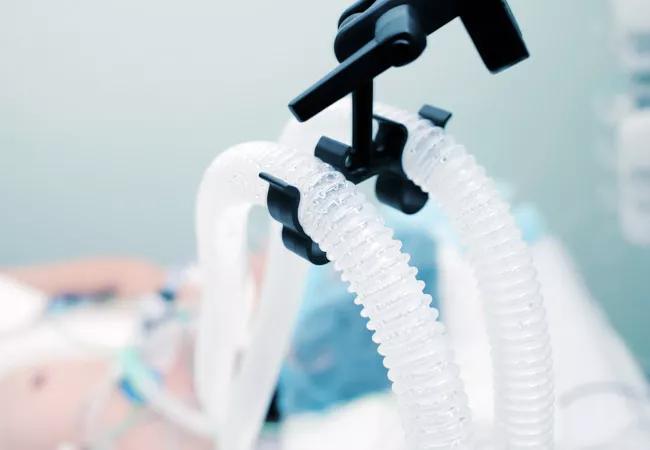Guides spontaneous awakening and breathing trials

Critically ill patients who are placed on mechanical ventilation are often started on sedation to keep them comfortable and decrease anxiety and agitation. However, prolonged and deep sedation can have repercussions, including delirium, a reduction in six-month mortality, and prolonged mechanical ventilation and stays in the intensive care unit.
Advertisement
Cleveland Clinic is a non-profit academic medical center. Advertising on our site helps support our mission. We do not endorse non-Cleveland Clinic products or services. Policy
ICU nurses at Cleveland Clinic South Pointe Hospital collaborated with respiratory therapists, pharmacy and physicians to create a protocol and monitoring tools for spontaneous awakening trials (SATs) and spontaneous breathing trials (SBTs) before extubation.
“When patients are on ventilators and we intubate them, we need to start thinking about extubating them, just as we begin planning discharge on day one when we admit a patient to the ICU,” says Saini Roman, MSN, RN, Nurse Manager of the ICU at South Pointe Hospital. “If we can start weaning our patients early and get them extubated and mobilized early, then we can decrease ICU length of stay.”
In 2019, a team of stakeholders mapped out the current process to better understand sedation practices and delays in extubating patients on ventilators.
“We discovered there wasn’t a standard for weaning patients at any particular time or date after they were ventilated,” says Nancy Hodge, MSN, RN, Assistant Nurse Manager in the ICU. “We wanted to create a consistent process.”
The team presented educational sessions for ICU nurses and respiratory therapists to review the evidence-based “ABCDEF” bundle for optimizing outcomes:
They rolled out a new process and accompanying tools for SATs and SBTs. Each day at 6:30 a.m., nurses turn off sedation for ventilated patients unless there is an order indicating the patient should remain sedated. Thirty minutes later, a respiratory therapist begins the weaning process. Caregivers use monitoring tools to guide SATs and SBTs.
Advertisement
“The tools lead nurses and respiratory therapists step by step through the screening process,” says Roman.
The flowchart guiding nurses through SATs begins by asking if the patient is on a ventilator and sedated. If the answer to both questions is yes, then the tool asks if the patient meets any of the following criteria: paralyzed or prone, induced hypothermia, acute myocardial infarction in last 24 hours, alcohol withdrawal, raised increased intracranial pressure, seizures and agitation greater than 2 on the Richmond Agitation Sedation Scale (RASS). If the nurse answers yes to any of the criteria, then the patient remains sedated. If none of the boxes are checked, then nurses proceed with the spontaneous awakening trial.
After stopping the sedation, nurses are guided to assess for the following: anxiety, pain or agitation, a respiratory rate higher than 35/minute, oxygen saturation less than 88%, respiratory distress and acute cardiac arrhythmia. If any of the conditions are present, nurses resume sedation at a lower dose and titrate to the ordered RASS. If not, then they inform respiratory therapists that they can proceed with a weaning trial, using the SBT flowchart to guide the process. The SAT and SBT monitoring tools are displayed on huddle boards and have since been added to the electronic medical record. Nurses discuss patient responses to SATs and SBTs at daily 8:15 a.m. huddles. When physicians round at 9 a.m., they visit patients who are weaning well first to begin extubation.
Advertisement
The protocol and monitoring tools have contributed to improved patient outcomes. Nurse leaders compared ICU length of stay (LOS) and ventilator days from January to November 2018, before implementation, and from January to November 2019, after implementation. In 2018, LOS per patient day (observed versus expected) was 1.06. In 2019, it dropped to 0.84. Ventilator days per patient day (observed versus expected) were 1.02 in 2018 and 0.83 in 2019.
The numbers have remained below the benchmark throughout the COVID pandemic. Cleveland Clinic rolled out the protocol and tools to other ICUs within the health system in 2020.
“We’ve been able to sustain momentum because of buy-in from frontline nurses, who understand the process of weaning patients off ventilators and the importance of following the protocol,” says Roman.
Advertisement
Advertisement

Nurses harness cutting-edge technology as a bridge to healing

Project aims to improve patient care by streamlining caregiver transitions

Optimizing care while protecting patients from life-threatening reactions

Palliative nurses improve quality of life

Strong bonds and momentous milestones fuel life-changing work

Experts offer hands-on support and education

Special skills course aims to improve patient safety and comfort while building caregiver confidence

Bariatric nurses deliver sensitivity, compassion and skill